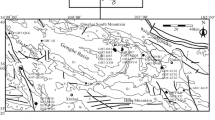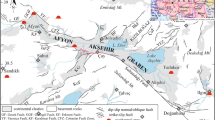Abstract
The thermal-waters resources in Weihe Basin of Shaanxi province, NW China are historically classified as middle- to low- temperature thermal-waters in China. Recent exploitation of the deep thermal reservoir in the centre part of the basin (i.e. Xi’an and Xianyang) had observed plentiful supply of thermal fluid with higher measured maximum temperature (120°C) and higher hydraulic pressure (80.50 MPa) in the deeper (more than 4,000 m deep) sedimentary basin. A recent isotope study shows that deep geothermal waters in the cities of Xi’an and Xianyang are characterized by an observable horizontal oxygen-18 (δ18O) shift and minor deuterium (2H) enrichment. The considerable oxygen shift is possibly due to the following four reasons: water–rock interaction at high temperature, slow circulation rate of water, low water-to-rock ratio, and old age. On the end number of the δ18O shift, minor δ2H enrichment occur when there is higher concentrations of H2S, CH4, I and Br with lower rate of rSO4 2−/rCl− and r +Na /r −Cl suggesting relatively isolated geological environment. In a few thermal waters points, \(r{\text{Na}}^{{\text{+}}} {\text{/}}r{\text{Cl}}^{-}\) < 0.85. This shows possible presence of formation waters. Combining the results from isotopic study and chemical analysis, we can classify the types of geothermal waters into three groups, the shallow and fast circulating system, the semi-circulating system and the deep and slow circulating system.







Similar content being viewed by others
References
Allis’on GB (1982) The relationship between 18O and deuterium in waters in sand columns undergoing aporation. J Hydrol 55:163–169
Arana V, Panichi C (1974) Isotopic composition of steam samples from Lanzarote, Canary Islands. Geothermics 3:142–145
Clark ID, Fritz P (1997) Environmental isotopes in hydrogeololgy [M]. Lewis Publishers, New York, pp 208–225
Cole DR, Ohmoto H (1986) Kinetics of isotope exchange at elevated temperatures and pressures, Chap 2. In: Valley JW, Taylor HP, O’Neil JR (eds) Stable isotopes in high temperature geological
Craig H (1963) The isotopic geochemistry of waters and Carbon in geothermal areas. In: Tongirogi E (ed) Nuclear geology on geothermal areas, Spoleto, 1963. Consiglio Nazionale delle Ricerche. Laboratorio di Geologia Nucleare, Pisa, pp 17–53
Criss RE (1991) Temperature dependence of isotopic fractionation factors. In: Taylor HP, O’Neil JR, Kaplan IR (eds) Stable isotopes geochemistry: a tribute to Samuel Epstein, The Geochemical Society Special Publication No. 3. San Antonio, TX, pp 11–16
Dajun Q, Shuhua T (2001) Isotope constraints on hydraulic relationship of groundwater between quaternary and tertiary aquifer in Xi’an area. Shaanxi province Science in China E:122–130
Dajun Q, Zhonghe P, Turner JV, Xiurong W, Yaodong Z, Xiaoli X, Tao L (2005) Isotopes of geothermal waters in Xi’an area and implications on its relation to karstic groundwaters in North Mountains[J]. Acta Petrol Sin 021(05):1489–1500
Fang L (2007) Report on geological investigation of thermal groundwater in Guanzhong Basin, Shaanxi province in Chinese, pp 34–38
Fisher DA (1991) Remarks on the deuterium excess in precipitation in cold regions. Tellus 43:401–407
Giggenbach WF (1988) Geothermal solute equilibria. Derivation of Na–K–Mg–Ca geoindicators. Geochim Cosmochim Acta 52:2749–2765
Giggenbach WF (1991) Chemical techniques in geothermal exploration. In: D’Amore F (ed) Application of geochemistry in geothermal reservoir development. UNITAR/UNDP publication, Rome, pp 119–142
Ma Z (2004) Environmental isotope for groundwater [M]. Xi’an: Shaanxi Scientific and Technological Publishing House, 10 (in Chinese)
Musgrove M, Banner J (1993) Regional ground-waters mixing and the origin of saline fluids: Midcontinent, United States. Science 259:1877–1882
Truesdell AH, Hulston JR (1980) Isotopic evidence of environments of geothermal systems, Chap 5. In: Fritz P, J-Ch Fontes (eds) Handbook of environmental isotope geochemistry, vol 1, The terrestrial environment, A. Elsevier, Amsterdam, pp 179–226
Acknowledgments
The work described has been carried out with the financial support of the China Geological Survey Bureau and the National Science Foundation of China.
Author information
Authors and Affiliations
Corresponding author
Rights and permissions
About this article
Cite this article
Ma, Z., Yu, J., Su, Y. et al. δ18O shifts of geothermal waters in the central of Weihe Basin, NW China. Environ Earth Sci 59, 995–1008 (2010). https://doi.org/10.1007/s12665-009-0092-7
Received:
Accepted:
Published:
Issue Date:
DOI: https://doi.org/10.1007/s12665-009-0092-7




